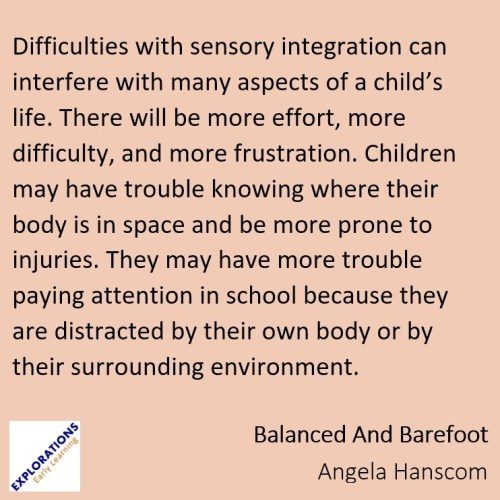
About Sensory Integration
Doctor Anna Jean Ayres, an American occupational therapist, first described sensory integration as “the organization of the senses for use” in 1972.
More formally, sensory integration is defined as:
the neurological process that organizes sensation from one’s own body and the environment, thus making it possible to use the body effectively within the environment. Specifically, it deals with how the brain processes multiple sensory modality inputs into usable functional outputs. It has been believed for some time that inputs from different sensory organs are processed in different areas in the brain. The communication within and among these specialized areas of the brain is known as functional integration. Newer research has shown that these different regions of the brain may not be solely responsible for only one sensory modality, but could use multiple inputs to perceive what the body senses about its environment. Sensory integration is necessary for almost every activity that we perform because the combination of multiple sensory inputs is essential for us to comprehend our surroundings.
wikia.org
Also known as sensory processing, sensory integration is important because it is at the core of how we engage the world around us. According to Kid Sense, “When children are efficient in their processing, appropriate responses to the environment around them occurs and is demonstrated by appropriate skill mastery, behaviour, attention and self regulation (controlling their physical activity, emotional and cognitive responses). Children are able to sit and attend to the important pieces of information in a classroom and therefore have a good chance at achieving their academic potential. Furthermore, the child is able to understand their body’s movement in relation to their surroundings and themselves. This allows for success in whole body (gross motor) activities. This in turns aids the social development of the child.”


For efficient sensory integration to exist, all the body’s sensory systems (visual, auditory, tactile, gustatory, olfactory, proprioceptive, vestibular, and interoceptive systems) must work together.

It turns out that play and being active in the world is the way young humans integrate their senses. According to pediatric occupational therapist, author of Balanced And Barefoot, and co-host of the TimberNook Tips podcast, Angela Hanscom, “If children were given ample opportunities to play outdoors every day with peers, there would be no need for specialized exercises or meditation techniques for the youngest of our society. They would simply develop these skills through play. That’s it. Something that doesn’t need to cost a lot of money or require much thought. Children just need the time, the space, and the permission to be kids.”
Listen to Angela Hanscom discuss sensory integration in episode 0007 of the TimberNook Tips podcast.
Offering abundant opportunities for children to play and engage the world with all their senses is the best thing early learning settings can do to support sensory integration. Parents should be leery of early learning settings that require children to spend lots of time sitting still.
Contribute content to Playvolution HQ
Brought to you by Explorations Early Learning
Thoughts On This Entry?
I’d love to hear your thoughts on improving this entry and suggestions for additional glossary additions in the comments below. You can also contact me with comments or concerns.
Browse Trainings
Post Author
Jeff Johnson is an early learning trainer, podcaster, and author who founded Explorations Early Learning, Playvolution HQ, and Play Haven.


Leave a Reply